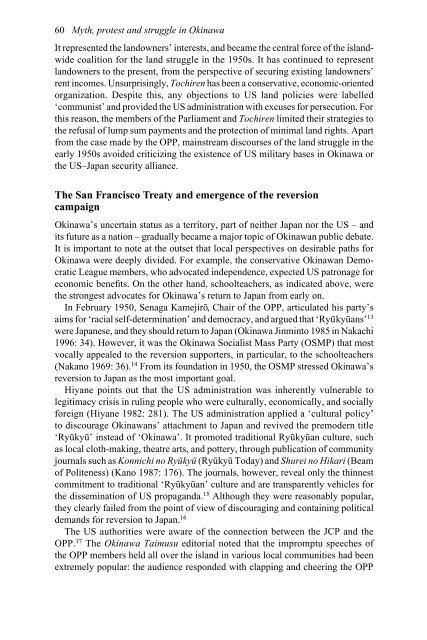Myth, Protest and Struggle in Okinawa
Myth, Protest and Struggle in Okinawa
Myth, Protest and Struggle in Okinawa
You also want an ePaper? Increase the reach of your titles
YUMPU automatically turns print PDFs into web optimized ePapers that Google loves.
60 <strong>Myth</strong>, protest <strong>and</strong> struggle <strong>in</strong> Ok<strong>in</strong>awa<br />
It represented the l<strong>and</strong>owners’ <strong>in</strong>terests, <strong>and</strong> became the central force of the isl<strong>and</strong>wide<br />
coalition for the l<strong>and</strong> struggle <strong>in</strong> the 1950s. It has cont<strong>in</strong>ued to represent<br />
l<strong>and</strong>owners to the present, from the perspective of secur<strong>in</strong>g exist<strong>in</strong>g l<strong>and</strong>owners’<br />
rent <strong>in</strong>comes. Unsurpris<strong>in</strong>gly, Tochiren has been a conservative, economic-oriented<br />
organization. Despite this, any objections to US l<strong>and</strong> policies were labelled<br />
‘communist’ <strong>and</strong> provided the US adm<strong>in</strong>istration with excuses for persecution. For<br />
this reason, the members of the Parliament <strong>and</strong> Tochiren limited their strategies to<br />
the refusal of lump sum payments <strong>and</strong> the protection of m<strong>in</strong>imal l<strong>and</strong> rights. Apart<br />
from the case made by the OPP, ma<strong>in</strong>stream discourses of the l<strong>and</strong> struggle <strong>in</strong> the<br />
early 1950s avoided criticiz<strong>in</strong>g the existence of US military bases <strong>in</strong> Ok<strong>in</strong>awa or<br />
the US–Japan security alliance.<br />
The San Francisco Treaty <strong>and</strong> emergence of the reversion<br />
campaign<br />
Ok<strong>in</strong>awa’s uncerta<strong>in</strong> status as a territory, part of neither Japan nor the US – <strong>and</strong><br />
its future as a nation – gradually became a major topic of Ok<strong>in</strong>awan public debate.<br />
It is important to note at the outset that local perspectives on desirable paths for<br />
Ok<strong>in</strong>awa were deeply divided. For example, the conservative Ok<strong>in</strong>awan Democratic<br />
League members, who advocated <strong>in</strong>dependence, expected US patronage for<br />
economic benefits. On the other h<strong>and</strong>, schoolteachers, as <strong>in</strong>dicated above, were<br />
the strongest advocates for Ok<strong>in</strong>awa’s return to Japan from early on.<br />
In February 1950, Senaga Kamejirō, Chair of the OPP, articulated his party’s<br />
aims for ‘racial self-determ<strong>in</strong>ation’ <strong>and</strong> democracy, <strong>and</strong> argued that ‘Ryūkyūans’ 13<br />
were Japanese, <strong>and</strong> they should return to Japan (Ok<strong>in</strong>awa J<strong>in</strong>m<strong>in</strong>to 1985 <strong>in</strong> Nakachi<br />
1996: 34). However, it was the Ok<strong>in</strong>awa Socialist Mass Party (OSMP) that most<br />
vocally appealed to the reversion supporters, <strong>in</strong> particular, to the schoolteachers<br />
(Nakano 1969: 36). 14 From its foundation <strong>in</strong> 1950, the OSMP stressed Ok<strong>in</strong>awa’s<br />
reversion to Japan as the most important goal.<br />
Hiyane po<strong>in</strong>ts out that the US adm<strong>in</strong>istration was <strong>in</strong>herently vulnerable to<br />
legitimacy crisis <strong>in</strong> rul<strong>in</strong>g people who were culturally, economically, <strong>and</strong> socially<br />
foreign (Hiyane 1982: 281). The US adm<strong>in</strong>istration applied a ‘cultural policy’<br />
to discourage Ok<strong>in</strong>awans’ attachment to Japan <strong>and</strong> revived the premodern title<br />
‘Ryūkyū’ <strong>in</strong>stead of ‘Ok<strong>in</strong>awa’. It promoted traditional Ryūkyūan culture, such<br />
as local cloth-mak<strong>in</strong>g, theatre arts, <strong>and</strong> pottery, through publication of community<br />
journals such as Konnichi no Ryūkyū (Ryūkyū Today) <strong>and</strong> Shurei no Hikari (Beam<br />
of Politeness) (Kano 1987: 176). The journals, however, reveal only the th<strong>in</strong>nest<br />
commitment to traditional ‘Ryūkyūan’ culture <strong>and</strong> are transparently vehicles for<br />
the dissem<strong>in</strong>ation of US propag<strong>and</strong>a. 15 Although they were reasonably popular,<br />
they clearly failed from the po<strong>in</strong>t of view of discourag<strong>in</strong>g <strong>and</strong> conta<strong>in</strong><strong>in</strong>g political<br />
dem<strong>and</strong>s for reversion to Japan. 16<br />
The US authorities were aware of the connection between the JCP <strong>and</strong> the<br />
OPP. 17 The Ok<strong>in</strong>awa Taimusu editorial noted that the impromptu speeches of<br />
the OPP members held all over the isl<strong>and</strong> <strong>in</strong> various local communities had been<br />
extremely popular: the audience responded with clapp<strong>in</strong>g <strong>and</strong> cheer<strong>in</strong>g the OPP
















